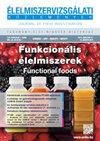Identification of Quality of Complex Flavour Mixtures Used in Meat Industry
Q4 Agricultural and Biological Sciences
引用次数: 0
Abstract
Multifunctional complex flavour mixtures, which simplify and speed up food production, are of great importance in the meat processing industry. The aim of the research was to identify the quality of complex food spice mixes prepared by a producer. It was found that the compositions of the grill spice mix met the regulations in terms of organoleptic, physical, and chemical parameters. The garlic mixture sample revealed the presence of edible salt, not declared by the manufacturer. Dietary fiber was present in all the mixes under study. Garlic 1:6 sample differed from the other complex additives by the increased content of Al, Li, Mg, P, Si, Sr, Te, as well as the presence of Mo, Ti, V, and W. The ‘grill spice mix’ had relatively high amounts of Ca, Cr, and Fe, but did not contain detectable amount of Si, declared by the manufacturer as part of E551. The composition of the grill spice mix stood out because of the high content of Mn, Na, and Zn, an aroma mixture – Cu. It should be noted that E627 and E631 flavor enhancers were found in an aroma mixture, whereas E450 stabilizer and emulsifier was found in a grill aroma mixture. According to a number of experts, these components pose a threat to the human body as they can cause intestinal and stomach disorders. In this regard, it is necessary to understand which food additives need to be excluded from a person’s diet, which are especially dangerous, and which are safe to consume from time to time in small quantities as part of meat products.肉类工业用复合香料混合物的质量鉴定
多功能复合风味混合料,简化和加快了食品生产,在肉类加工工业中具有重要意义。这项研究的目的是鉴定生产商配制的复杂食品香料混合物的质量。结果表明,该烧烤香料混合物的感官、物理和化学参数均符合规定。大蒜混合物样本显示含有可食用盐,但制造商没有申报。所有被研究的混合物中都含有膳食纤维。大蒜1:6样品与其他复合添加剂的不同之处是Al、Li、Mg、P、Si、Sr、Te的含量增加,以及Mo、Ti、V和w的存在。“烧烤香料混合物”中Ca、Cr和Fe的含量相对较高,但不含可检测到的Si,制造商称其为E551的一部分。烧烤香料混合物的组成脱颖而出,因为Mn, Na和Zn含量高,一种香气混合物- Cu。值得注意的是,在香气混合物中发现了E627和E631增味剂,而在烧烤香气混合物中发现了E450稳定剂和乳化剂。据一些专家称,这些成分对人体构成威胁,因为它们会导致肠道和胃部紊乱。在这方面,有必要了解哪些食品添加剂需要从一个人的饮食中排除,哪些特别危险,哪些作为肉类产品的一部分偶尔少量食用是安全的。
本文章由计算机程序翻译,如有差异,请以英文原文为准。
求助全文
约1分钟内获得全文
求助全文
来源期刊

Elelmiszervizsgalati Kozlemenyek
Agricultural and Biological Sciences-Food Science
CiteScore
0.20
自引率
0.00%
发文量
10
期刊介绍:
The main topics, which we are waiting to issue in our paper, are the next:
Chemical food and feed analysis (ingredients, macro-, mezo- and micro components, harmful pollutants, processing by-products etc.);
General food and feed chemistry related to several food and feed processing technologies;
Food and feed toxicology;
Relation between the agro technology and the food chain safety;
Microbiological food and feed analysis (pathogens, spoilage bacteria, general food/feed microbiology, microorganisms of several processing technologies etc.);
Rapid food and feed test methods (“classical” and instrumental technologies);
Molecular biological food and feed analysis (GMOs, GMO analysis etc.)
Effects of genetically modified organisms on the entire food chain and the environment;
Sensorial food and feed analysis;
Investigation of non-food products (mainly several disinfectants, production aids);
Investigation of food contact materials (migration tests, residual investigations, etc.);
Legislation topics, regulation of the whole food chain on the territory of food and feed processing, retailing, distribution (European, Hungarian, other countries);
Standardisation news and comments on the topics of whole food chain;
Other topics, results of investigations etc. (the Editorial Board keeps the right to measure the manuscripts arriving to the Editorial Office according to the principles of the journal).
 求助内容:
求助内容: 应助结果提醒方式:
应助结果提醒方式:


